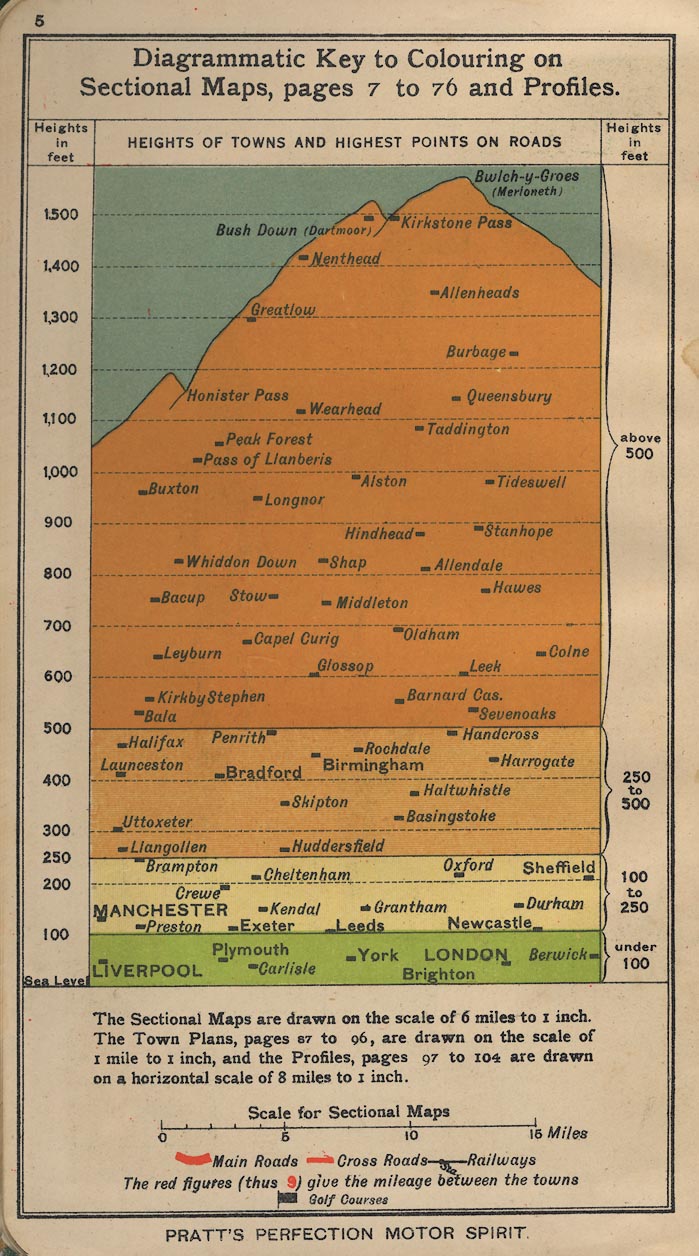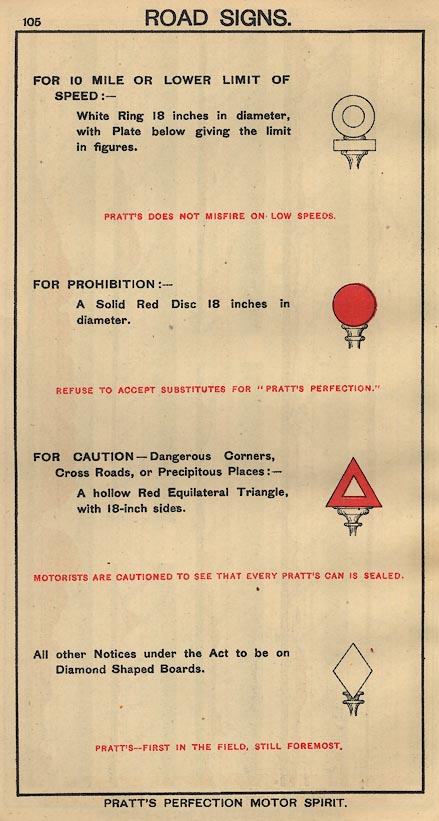
 Map Group PRATT 1905
Map Group PRATT 1905

These notes are strongly biased towards a Hampshire interest.





PRATT'S PERFECTION MOTOR SPIRIT ... PRATT'S ROAD ATLAS OF ENGLAND AND WALES 6/- NET ANGLO-AMERICAN OIL CO., LTD.
PURVEYORS OF MOTOR SPIRIT TO H.M. THE KING. H.M. QUEEN ALEXANDRA. PRATT'S ROAD ATLAS OF ENGLAND AND WALES FOR MOTORISTS
COPYRIGHTED 1905 Published by ANGLO-AMERICAN OIL CO., LTD., 36-38 QUEEN ANNE'S GATE, WESTMINSTER, LONDON, S.W. Engraved and Printed by George Philip & Son, Ltd., 32 Fleet Street, London E.C. REVISED EDITION, 1915.
LIGHTING UP TIMES
PERPETUAL LIGHTING-UP TABLE
The above figures are for London and District; in other parts of the country the times vary to the extent of a few minutes. The figures in italics for the months from April to September inclusive represent 'Summer Time'.
GENERAL MAPS
ADVERTISEMENTS



The dominant element of this is the:-
Diagrammatic Key to Colouring on Sectional Maps, pages 7 to 76, and Profiles.Layer colouring is displayed as a mountain diagram, with a selection of places at their proper heights. The only Hampshire place is Basingstoke at about 325 feet. Map scales are declared:-
The Sectional Maps are drawn to a scale of 6 miles to 1 inch. The town plans, pages 87 to 96 are drawn on the scale 1 mile to 1 inch, and the Profiles, pages 97 to 104 are drawn on a horizontal scale of 8 miles to 1 inch.Below is a scale line:-
Scale for Sectional Mapsand some map symbols:-
[bold red line] Main Roads [red line] Cross Roads [black line] Railways
The red figures (thus 9) give the mileage between the towns
[square black flag] Golf Courses
up is N

All the map have a piano key border around the open spread of two pages, which, printed separately, are designed as one map unit.
The page numbers for adjoining sheets are printed in a circle in the borders. For example, most of Hampshire is on pp.11-12, two landscape pieces. The adjoining sheets are 9 to the east, 29, 20, 31 to the north, 13,14 to the west. Sea is to the south.
scale

Scale for Sectional Mapsmarked in miles to 5 then at 5 mile intervals. The 15 miles = 63.5 mm gives a scale 1 to 380160. The road map scale is about:-
1 to 380000
6 miles to 1 inch

50 [degrees] 40 [minutes]
1 [degree]
20 [minutes]Reading as accurately as possible from the map
longitude, Winchester = 1d 18.6m Wwhich accords with a prime meridian at Greenwich; Winchester is usually taken as being 1d 18.4m W.
sea tinted

The sea area is printed blue, with some sea areas labelled, eg:-
The Solent
Spithead
Southampton Water
harbours
Harbours are clearly recognisable, but not labelled.

Above their estuaries, which are printed blue with the sea, rivers are drawn by a wiggly line tapering upstream. Some rivers are labelled, eg:-
Test
ItchenThe rivers shown in Hampshire include all the major streams; Stour, Avon, Lymington, Beaulieu, Test, Itchen, Hamble, Meon, Rother, Wey, Blackwater, Hart, Lyde, Loddon, Enborne, and a few tributaries.
layer colouring

Relief is shown by layer colouring, printed without contour lines at the edges. The layers do not have equal vertical intervals. The table of symbols on a preface page explains:-
Heights in feet
under 100 [green]
100 to 250 [yellow]
250 to 500 [pale orange]
above 500 [orange]The bold colours give the road maps a jolly appearance. Hills, downs, etc are generally not labelled.
NEW FORESTarea is labelled.
town

WINCHESTER
WHITCHURCHLarger towns might be labelled in a slightly larger, serifed, block caps; in Hampshire:-
SOUTHAMPTON
PORTSMOUTH
village
hamlet

Lymington
Alton
Stockbridge
Beaulieu
Middle Wallop

Oakley Sta.
Fleet Sta.

Only one miscellaneous feature is regularly marked, golf courses, by a small black rectangular flag on a low post. In Hampshire these are at:-
Aldershot, Alton, Andover, Basingstoke, Bishops Waltham, Bordon, Botley, Brockenhurst, Burley, Christchurch, Cosham, Fareham, Fleet, Gosport, Hartley Row, Lee on the Solent, Lymington, Lyndhurst, Milton, New Alresford, North Tidworth, Petersfield, Portsmouth, Preston Candover, Romsey, Rowlands Castle, South Hayling, Southampton, Swaythling, Winchester.


road distances
gradient diagrams

The network of roads is drawn by solid red lines, broad and narrow for main road and cross roads (a surprisingly old fashioned term?). Distances between towns are marked beside roads by red figures. You have to be careful how distances are understood, from which place to which?
The major routes across Hampshire are:-
from London; through Bagshot, Surrey; then Blackwater, Basingstoke, Whitchurch, Andover, Hampshire; Amesbury, Wiltshire; and west to Exeter, devon; and Lands End, Cornwall.
branch from basingstoke, through Sutton Scotney, and Stockbridge, Hampshire; then Salisbury, Wiltshire; and west.
branch from the Basingstoke-Stockbridge road, through Popham to Winchester, Hampshire AND from Winchester through Romsey, Lyndhurst, Hampshire, then Christchurch to Poole, Dorset; and beyond.
from London; through Bagshot, Surrey; across a corner of Hampshire; through Farnham, Surrey; then Alton, New Alresford, Winchester, to Southampton, Hampshire AND from Southampton, Hampshire; to Salisbury, Wiltshire AND a link to Lyndhurst etc.
from London; through Guildford and Godalming, Surrey; then Liphook, Petersfield, Horndean, Cosham, to Portsmouth, Hampshire.
from Southampton, through Fareham, Cosham, Havant, Hampshire; to Chichester, West Sussex; and beyond AND a branch from Fareham to Gosport, Hampshire.
from Oxford, Oxfordshire; through Newbury, Berkshire; then Whitchurch to Winchester, Hampshire.
The pages after the road maps have gradient diagrams, road profiles, of a number of the main routes. The horizontal scale is about 8 miles to 1 inch; the base line marked and labelled at 5 mile intervals. The vertical scale is about 1100 feet to 1 inch; there are horizontal rules at 100, 250 and 500 feet, and the 'land' below the road line is layer coloured. Various places, settlements on hill tops, are labelled along the route. Each road profile is titled.
The road profiles that cross Hampshire are:-

LONDON TO PORTSMOUTH - from London, through Guildford and Godalming, and climb over Hindhead, Surrey; then Liphook, over hills via Rake to Sheet and Petersfield, up over War Down, down through Horndean and Waterloo, up over Portsdown, down to Cosham, Hilsea and Portsmouth, Hampshire.
LONDON TO SALISBURY - from London; through Bagshot, Surrey; over low hills to Blackwater, Hartford Bridge, Hartley Row, Hook, Nately Scures, Basingstoke, Worting, Oakley Sta, Overton, Whitchurch, Hurstbourne Priors, Andover, Middle Wallop, Hampshire; then up over downs to Salisbury, Wiltshire.
Page 105 illustrates types of four road sign:-

White ring; for a 10 mile per hour speed limit, or less.
Red disk; prohibition.
Red triangle; caution.
White diamond for other 'Notices under the Act'.These signs are the first official road signs, defined by government legislation, the Motor Car Act 1903. There was a general speed limit of 20 miles an hour in 1903, so the lower speed restriction was all that was needed.
Hands, Stuart: 2002: Road Signs: Shire Publications:: ISBN 0 7478 0531 8
Page 106 gives a table giving the speed in miles per hour against the time for 1 mile. The times are in minutes and seconds from 1 min. 0 sec. in steps of 1 second, to 6 min. 0 sec, a range of speeds from 60 mph to 10 mph. This is particularly useful if there was still a general speed limit of 20 miles per hour!




